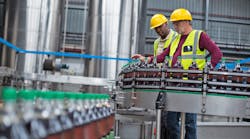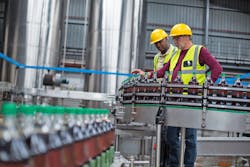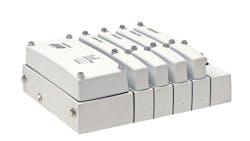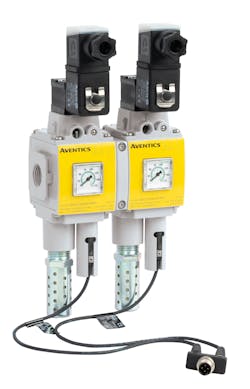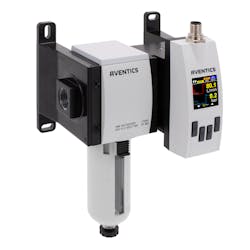The market for packaged food and beverages in the U.S. is predicted to grow at an annual rate of just over 4% from now until 2028. Fueling that growth are consumer demands for safety and convenience. One way companies are trying to keep up with those demands and the anticipated growth in packaged foods is by focusing on automating the packaging processes.
A key tool companies have been relying on for the handling and motion control aspects of automating food packaging is pneumatics. That’s because pneumatics such as valves and air actuators are clean, reliable, precise, easy to maintain and increase throughput.
Here are several recent advances in the cleanliness, safety and efficiency of pneumatics that are helping food companies automate and improve their packaging systems.
Keeping it Clean
A critical requirement for components used for food and beverage packaging is that they can meet stringent regulations for food contact. For example, they must be designed to withstand repeated washdown procedures.
Traditionally, valves have been housed in cabinets or other enclosures to protect sensitive components from wet or harsh environments. Although stainless steel cabinets provide the necessary protection, they can be expensive.
The latest valves—like those used in vacuum packaging—have IP69K ratings, the highest protection class. This rating indicates the valves and other similarly rated components provide protection from dust, high temperatures and pressure wash-down liquids. This makes these valves ideal for packaging and food processing where machinery must be thoroughly sanitized. To keep the process even cleaner, companies use NSFH1 (food-grade) lubricants in their valves for added safety.
Along with the highest cleanliness level, these valves also feature improved cylinder performance which uses air per cycle for better response times and increased energy savings. Having shorter compressed air lines from the valve to the cylinder equates to less volume to fill and exhaust, improving cylinder performance.
Valves are designed for easy cleaning and built from durable, clean materials. One leading pneumatic valve supplier, for example, offers an IP69K-rated valve with no joints or gaps that uses stainless steel components and polymers appropriate for high-pressure washdowns with aggressive detergents.
In addition to hygienic designs, the latest valves can be configured to meet the needs of a host of applications and will work with a wide range of communication protocols. Many also work with pneumatic actuators. Some valve companies provide online configuration tools that make it easy for design engineers to quickly access CAD drawings, schematics, part numbers and ancillary related components.
Keeping it Safe
No matter how well designed and built, all automation equipment needs routine and scheduled maintenance, as well as servicing to remedy problems due to electrical, mechanical or process issues.
To keep machine shutdowns few and safe, companies making consumer packaged goods use various forms of functional safety that most commonly adhere to ISO 13849. The standard stipulates that when technicians need to enter a machine enclosure, all moving systems are in a “safe” condition.
Whether it is a complete lockout/tag-out or implementation of the “minor servicing exception,” the most common method used to render pneumatic components “safe” is to release the pneumatic energy. The preferred component with which to do that is a redundant safety exhaust valve (RSEV). It can be part of an air-preparation subsystem that feeds compressed air to a machine or section of the machine.
Risk assessments indicate that lots of equipment requires a Category 3 PLd safety device (ISO 13849-1) to keep it safe during repairs and servicing tasks. The device must have redundant circuits. RSEVs meet this need by using redundant valves and diagnostics from sensors, such as spool-position monitoring, to ensure stored energy (i.e., compressed air) is released and removed.
When a device such as a safety gate on a machine enclosure is triggered, two safety outputs are sent to the RSEV. If one valve fails, the redundant valve will still complete the safety function. Diagnostics coverage will raise an alarm so that action can be taken to address the failure before operations resume.
Some redundant safety valves feature built-in soft starts. Upon start-up, this feature ensures pressure remains at 60% to 70% of final system pressure before opening fully. The slow buildup of pressure/force, as actuators move to their home/start position, prevents damage to components and equipment.
Keeping it Efficient
Smaller carbon footprints are goals in nearly every industry, including the food and beverage sectors. This means lowering energy consumption and devising better ways to control energy use in food-packaging facilities.
One focus in these efforts looks at compressed air consumption, a significant source of energy use in packaging. If left undetected and unaddressed, air leaks can waste substantial amounts of energy and money.
To stem these losses, many companies are outfitting new and existing machines with air flow sensors. They continuously monitor compressed air flow and can help operators detect and address leaks earlier, minimizing energy losses and costs.
By continually measuring process parameters, including pressure, temperature, mass and volumetric flow rates, flow velocity, total mass, total volume and energy, sensors let operators track air consumption and energy use. Operators can then use that data to locate and address potential problems, such as leaks, before they occur. By preventing leaks, facilities improve energy efficiency while reducing downtime and costs.
Air flow sensors are suitable for facilities of any size. Some air flow sensors let operators see data at the machine level. They also let facilities keep collected data within their own IT network without connecting to the cloud. Facilities can also connect sensors to a gateway to access other data for additional insights. Air flow control valve manufacturers experienced in digital transformation can help facilities decide what is most suitable for their individual needs and goals.
The latest trends in food packaging automation let packaging companies ensure that machines in their lines meet the highest machine safety, energy efficiency and hygiene standards. Leading pneumatic suppliers continually enhance the reliability, data measurement and collection capabilities, and connectivity, to make food packaging efficient, productive and safe.
Christine Hoffman is a product marketing manager for Air Preparation, Sensors and Accessories, and Tom Voth is a product marketing manager for Pneumatic Proportional Products and Safety Systems, both at Emerson.
